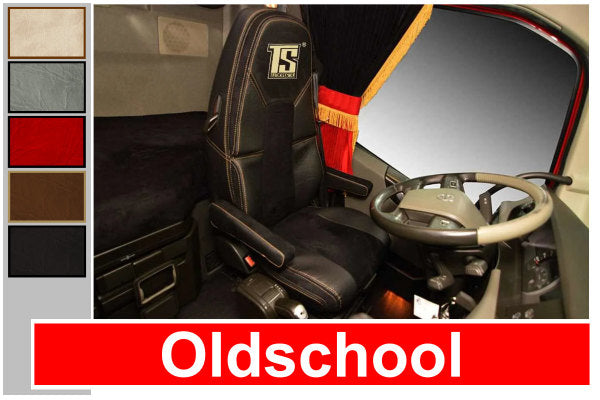Driving Comfortably Seat Cushions for Lumbar Support
Driving long distances or spending extended periods behind the wheel can put a strain on your body, particularly your lower back. While adjustable seats and ergonomic car designs can help mitigate discomfort, adding a seat cushion specifically designed for lumbar support can significantly improve your driving experience.
In this guide, we will dive into the importance of lumbar support while driving, how to choose the right seat cushion for your needs, and provide tips on how to use and make your own seat cushion for lumbar support. We will also discuss common mistakes to avoid and alternative options for those who may not prefer using seat cushions. Let's get started!
The Importance of Lumbar Support While Driving

The lumbar region of our spine is responsible for supporting most of our upper body weight while sitting. This area is especially vulnerable to strain and pain due to prolonged sitting, poor posture, or inadequate support. According to research, 70-85% of people experience lower back pain at some point in their lives, and driving is known to be a contributing factor.
When you sit in a car, the natural S-shaped curve of your spine tends to flatten due to the pressure from the seat. This can cause your lower back muscles to work harder to maintain proper posture, leading to fatigue, discomfort, and pain. Over time, this can even result in more severe spinal conditions such as herniated discs or sciatica.
Proper lumbar support while driving helps maintain the natural curvature of your spine, reducing stress on your back muscles and tissues. It can also improve blood circulation, reduce tension, and alleviate pain and discomfort. This is where seat cushions for lumbar support come in.
Choosing the Right Seat Cushion for Lumbar Support

With numerous seat cushions available in the market, selecting the right one for your specific needs and car seat can be daunting. Here are key factors to consider:
1. Shape and Size
The shape and size of a seat cushion greatly impact its effectiveness in providing lumbar support. Here are some common types of sseat cushions for lumbar support and their benefits:
- Contoured cushions: These follow the curve of your lumbar spine, providing targeted support where you need it the most. This type of cushion is ideal for those with specific lower back pain issues or those who prefer a more customized fit.
- Wedge-shaped cushions: These are positioned between the seatback and your back, filling in any gaps and reducing stress on your lower back. They are also beneficial for people with sciatica or hip pain, as they can help distribute weight evenly and alleviate pressure points.
- Full-length cushions: As the name suggests, these cushions provide comprehensive support for your entire back. They are ideal for those with overall back discomfort or for those who tend to shift around in their seats while driving.
- Half-cushions: These focus on supporting the lower back, often leaving room for leg movement. They are perfect for people who prefer a less rigid feel or those looking for added support without losing flexibility.
It's essential to consider the shape and size of the cushion in relation to your car seat. Make sure to measure your seat and compare it to the dimensions of the cushion before making a purchase.
2. Material
The material of a seat cushion determines its firmness, durability, and comfort level. Here are some common materials used in seat cushions for lumbar support:
- Foam: This is the most versatile and affordable option and offers varying degrees of firmness. Memory foam, in particular, is popular for its ability to conform to the shape of your body, providing excellent support and pressure relief.
- Gel: These cushions are made with a gel-like substance that distributes weight evenly, reduces pressure points, and keeps you cool. They are particularly beneficial for people who tend to get hot and sweaty while sitting for extended periods.
- Air: These cushions are adjustable and allow you to control the amount of lumbar support by inflating or deflating them. They are ideal for people with specific back pain issues, as they can tailor the support level to their needs.
Aside from these materials, some cushions also come with additional features such as heat therapy, massage, or vibration, which can provide added comfort and relaxation.
How to Use a Seat Cushion for Lumbar Support

Once you have chosen the right seat cushion for your needs, it's essential to know how to use it correctly to reap its benefits fully. Here are some tips on how to use a seat cushion for lumbar support:
- Position the cushion in the curve of your lower back, between the seatback and your back.
- Make sure the cushion is secured in place and does not move around while driving.
- Adjust the cushion to your comfort level. Some cushions may come with straps or buckles that allow you to adjust the firmness or placement of the cushion.
- Sit back comfortably into the cushion without slouching or leaning forward.
- Take breaks to stretch and move around if you are driving for an extended period.
- If you are using a heated or vibrating cushion, make sure to follow the manufacturer's instructions and avoid prolonged use to prevent burns or excessive vibration.
Benefits of Using a Seat Cushion for Lumbar Support

The benefits of using a seat cushion for lumbar support go beyond just alleviating back pain and discomfort. Here are some other advantages of using a seat cushion while driving:
1. Improved posture
Proper lumbar support encourages you to sit with better posture, reducing strain on your back muscles and promoting spinal health.
2. Reduced fatigue
When your back is adequately supported, your muscles are less likely to become fatigued from working overtime to maintain proper posture. This can result in increased energy and focus while driving.
3. Increased comfort
A cushion that is tailored to your needs and preferences can greatly improve your overall comfort level while driving. This can make long drives more enjoyable and less taxing on your body.
4. Prevention of back problems
Using a seat cushion for lumbar support can prevent the development or worsening of back problems and conditions such as herniated discs, sciatica, and spinal stenosis.
Common Mistakes to Avoid When Using a Seat Cushion for Lumbar Support

While using a seat cushion can be highly beneficial, there are some common mistakes people make that can hinder its effectiveness. Here are some things to avoid when using a seat cushion for lumbar support:
1. Not adjusting the cushion properly
It's essential to adjust the cushion to your specific needs and preferences. A poorly adjusted cushion can do more harm than good, so take the time to find the right placement and firmness for maximum support.
2. Using a cushion that is too big or too small
Using a cushion that does not fit your car seat or your body can be counterproductive. Make sure to measure your seat and compare it to the dimensions of the cushion before purchasing.
3. Relying solely on a cushion for lumbar support
A seat cushion is meant to supplement and enhance your sitting experience, but it should not be your only form of lumbar support. It's important to also maintain proper posture and incorporate exercises and stretches to strengthen your back muscles.
Alternatives to Seat Cushions for Lumbar Support
While seat cushions are a popular option for lumbar support while driving, they may not work for everyone. Here are some alternatives to consider:
1. Lumbar support pillows
Similar to seat cushions, these pillows are designed to provide lumbar support while sitting. They can be used in the car, office, or at home and come in various shapes and sizes.
2. Mesh backrests
These backrests are made of a mesh material that contours to your body and provides adequate lumbar support. They are lightweight, portable, and easy to attach to most car seats.
3. Lumbar rolls
Lumbar rolls, also known as lumbar supports, are small cylindrical cushions that can be placed on your car seat to support your lower back. They come in different sizes and materials and can be easily adjusted for firmness.
4. Adjusting your car seat
If your car seat is adjustable, try altering the angle of the seatback to find a position that provides better lumbar support. You can also use a folded towel or blanket to fill in any gaps and provide additional support.
How to Make Your Own Seat Cushion for Lumbar Support
If you prefer a more personalized and cost-effective option, you may consider making your own seat cushion for lumbar support. Here's how:
Materials:
- High-density foam (can be found at most craft or home improvement stores)
- Fabric (preferably something sturdy and breathable)
- Scissors
- Measuring tape
- Ruler
- Sewing machine (optional)
Steps:
- Measure the width of your car seat and add two inches to account for seam allowance.
- Measure the height of the cushion you want and mark it on the foam. Use a ruler to draw a straight line across the foam.
- Cut the foam along the marked line using scissors or an electric knife.
- Repeat the process with the fabric, adding an extra inch on each side for seam allowance.
- Place the foam on top of the fabric, making sure the edges are aligned.
- Fold one end of the fabric over the foam and secure it with pins.
- Repeat on the opposite end.
- Sew along the two ends, leaving one side open.
- Turn the fabric inside out, creating a cover for the foam.
- Insert the foam into the cover.
- Fold the open side of the fabric inward and sew it closed.
Congratulations, you now have your own DIY seat cushion for lumbar support!
Frequently Asked Questions About Seat Cushions for Lumbar Support
Q: Can a seat cushion for lumbar support prevent back pain?
A: While using a seat cushion can greatly reduce the risk of developing back pain, it may not entirely prevent it. It's important to also maintain proper posture and take breaks to stretch and move around while driving.
Q: How long should I use a seat cushion for lumbar support?
A: This varies from person to person, but generally, using a cushion for 20-30 minutes at a time and taking breaks in between is recommended.
Q: Can I use a seat cushion for lumbar support in any type of car?
A: Yes, most seat cushions are designed to fit most car seats. However, it's essential to measure your seat and compare it to the dimensions of the cushion before purchasing.
Q: Can a seat cushion for lumbar support be used by people of all sizes?
A: Some cushions may be more suitable for larger or smaller individuals, so make sure to check the dimensions and adjustability options before buying.
Q: Do I need to replace my seat cushion regularly?
A: This depends on the quality and material of the cushion, as well as how often you use it. Generally, it's recommended to replace a cushion every 1-2 years to ensure it continues to provide adequate support.
Conclusion
Driving long distances or sitting in a car for extended periods can take a toll on your body, particularly your lower back. Using a seat cushion for lumbar support can greatly improve your driving experience by providing proper support and promoting spinal health. By considering the shape and size of the cushion, as well as the material, and following proper usage techniques, you can find relief from back pain and discomfort while on the road.
Remember to also incorporate good posture habits and exercises to strengthen your back muscles, and don't be afraid to try out different types of cushions until you find the right fit for you. With the help of this guide, you can now make an informed decision when choosing a seat cushion for lumbar support and enjoy a more comfortable and enjoyable driving experience.
Additional Resources
- "Back Pain Facts & Statistics." American Chiropractic Association, www.acatoday.org/Patients/Health-Wellness-Information/Back-Pain-Facts-and-Statistics.
- "Lumbar Support Pillows: How to Choose the Best One for You." Spine-health, www.spine-health.com/wellness/ergonomics/lumbar-support-pillows-how-choose-best-one-you.
- "Lower Back Pain Treatment." Mayo Clinic, www.mayoclinic.org/diseases-conditions/back-pain/diagnosis-treatment/drc-20369911.



